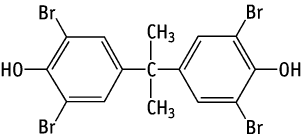

Oral toxicity of 4,4'-isopropylidenebis(2,6-dibromophenol) was studied in a 28-day repeat dose toxicity test in rats. Dose levels were 0, 8, 40, 200, and 1000 mg/kg.
No animals died or became moribund.
There were no changes in clinical observation, body weight, food consumption, hematological examination, blood chemical examination, urinalysis or pathological examination.
The NOEL is considered to be 1000 mg/kg/day for males and females from this study.
A reverse mutation test of 4,4'-isopropylidenebis(2,6-dibromophenol) on bacteria was carried out. This substance was not mutagenic in Salmonella typhimurium TA100, TA1535, TA98, TA1537 and Escherichia coli WP2 uvrA, with or without an exogenous metabolic activation system.
Genotoxicity of 4,4'-isopropylidenebis(2,6-dibromophenol) was studied by chromosomal aberration test using cultured Chinese hamster lung (CHL/IU) cells.
4,4'-Isopropylidenebis(2,6-dibromophenol) did not induce structural chromosomal aberrations or polyploidy at any dose, with or without a metabolic activation system.
| Purity | : | 99.5 % |
| Test species/strain | : | Rat/Crj:CD(SD)IGS |
| Test method | : | OECD test Guideline 401 |
| Route | : | Oral(gavage) |
| Dosage | : | 0(vehicle), 2000 mg/kg |
| Number of animals/group | : | Males, 5; females, 5 |
| Vehicle | : | 0.5 % CMC-Na aqueous solution mixed with 0.1 % Tween 80 |
| GLP | : | Yes |
Test results:
The LD50 value was considered to be more than 2000 mg/kg for males and females.
| Purity | : | 99.5 % |
| Test species/strain | : | Rat/Crj:CD(SD)IGS |
| Test method | : | Guideline for 28-Day Repeated Dose Toxicity Test in Mammalian Species (Chemical Substances Control Law of Japan) |
| Route | : | Oral(gavage) |
| Dosage | : | 0(vehicle), 8, 40, 200, 1000 mg/kg/day |
| Number of animals/group | : | Males, 12; females, 12(0, 200, 1000 mg/kg) Males, 6; females, 6(8, 40 mg/kg) |
| Vehicle | : | 0.5 % CMC-Na aqueous solution mixed with 0.1 % Tween 80 |
| Administration period | : | Males and females, 28 days |
| Terminal kill | : | Days 29 and 43 |
| GLP | : | Yes |
Test results:
The NOEL was considered to be 1000 mg/kg/day for males and females in this study.
| Purity | : | 99.5 % |
| Test species/strains | : | Salmonella typhimurium TA100, TA1535, TA98, TA1537, Escherichia coli WP2 uvrA |
| Test method | : | Guidelines for Screening Mutagenicity Testings of Chemicals (Chemical Substances Control Law of Japan) and OECD Test Guideline 471 |
| Procedures | : | Pre-incubation method |
| Solvent | : | Dimethyl sulfoxide |
| Positive controls | : | -S9 mix; 2-(2-Furyl)-3-(5-nitro-2-furyl)acrylamide (TA100, TA98, WP2 uvrA), Sodium azide (TA1535) and
9-Aminoacridine (TA1537) +S9 mix; 2-Aminoanthracene (five strains) |
| Doses | : | -S9 mix; 0, 78.1, 156, 313, 625, 1250, 2500 μg/plate(TA100) -S9 mix; 0, 19.5, 39.1, 78.1, 156, 313, 625 μg/plate(TA1535) -S9 mix; 0, 156, 313, 625, 1250, 2500, 5000 μg/plate(WP2 uvrA, TA98) -S9 mix; 0, 4.88, 9.77, 19.5, 39.1, 78.1, 156 μg/plate(TA1537) +S9 mix; 0, 156, 313, 625, 1250, 2500, 5000 μg/plate(TA100, TA98, TA1535, WP2 uvrA) +S9 mix; 0, 9.77, 19.5, 39.1, 78.1, 156, 313 μg/plate(TA1537) |
| S9 | : | Rat liver, induced with phenobarbital and 5,6-benzoflavon |
| Plates/test | : | 3(1 for cytotoxicity test) |
| Number of replicates | : | 2(plus 1 cytotoxicity test) |
| GLP | : | Yes |
Test results:
Genetic effects:
Salmonella typhimurium TA100, TA98, TA1535, TA1537
| + | ? | - | |
| Without metabolic activation: | [ ] | [ ] | [*] |
| With metabolic activation: | [ ] | [ ] | [*] |
Escherichia coli WP2 uvrA
| + | ? | - | |
| Without metabolic activation: | [ ] | [ ] | [*] |
| With metabolic activation: | [ ] | [ ] | [*] |
| Purity | : | 99.5 % |
| Type of cell used | : | Chinese hamster lung (CHL/IU) cells |
| Test method | : | Guidelines for Screening Mutagenicity Testing of Chemicals (Chemical Substances Control Law of Japan) and OECD Test Guideline 473 |
| Solvent | : | Dimethyl sulfoxide |
| Positive controls | : | -S9 mix; Mitomycin C +S9 mix; Cyclophosphamide |
| Doses | : | -S9 mix(short-term treatment); 0, 0.0016, 0.0033, 0.0065 mg/mL +S9 mix(short-term treatment); 0, 0.0075, 0.015, 0.030 mg/mL -S9 mix(continuous treatment for 24 hr); 0, 0.015, 0.030, 0.060 mg/mL |
| S9 | : | Rat liver, induced with phenobarbital and 5,6-benzoflavone |
| Plates/test | : | 2 |
| GLP | : | Yes |
Test results:
Genotoxic effects:
| clastogenicity | polyploidy | |||||
| + | ? | - | + | ? | - | |
| Without metabolic activation: | [ ] | [ ] | [*] | [ ] | [ ] | [*] |
| With metabolic activation: | [ ] | [ ] | [*] | [ ] | [ ] | [*] |
| 1) | The tests were performed by the Mitsubishi Chemical Safety Institute Ltd., 14 Sunayama, Hasaki-machi, Kashima-gun, Ibaraki, 314-0255, Japan. Tel +81-479-46-2871 Fax +81-479-46-2874 |
| 2) | The tests were performed by the Hatano Research Institute, Food and Drug Safety Center, 729-5 Ochiai, Hadano-shi, Kanagawa, 257-8523, Japan. Tel +81-463-82-4751 Fax +81-463-82-9627 |